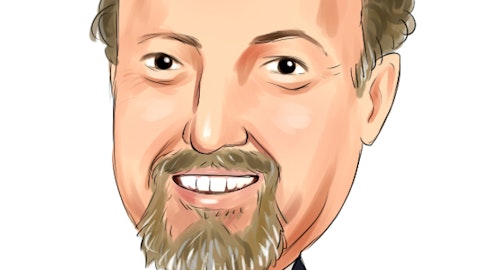KeyCorp (NYSE:KEY) Q4 2022 Earnings Call Transcript January 19, 2023
Operator: Good morning, and welcome to KeyCorp’s Fourth Quarter 2022 Earnings Conference Call. As a reminder, this conference is being recorded. I would now like to turn the conference over to the Chairman and CEO, Chris Gorman. Please go ahead.
Chris Gorman: Well, thank you for joining us for KeyCorp’s fourth quarter 2022 earnings conference call. Joining me on the call today are Don Kimble, our Chief Financial Officer; Clark Khayat, our Chief Strategy Officer. Upon Don’s planned retirement, Clark will assume the CFO role; and also Mark Midkiff, our Chief Risk Officer. On slide 2, you will find our statement on forward-looking disclosure and non-GAAP financial measures. It covers our presentation materials and comments as well as the question-and-answer segment of our call. I’m now moving to slide 3. This morning, we reported earnings of $356 million or $0.38 per common share. Our results included $265 million of provision for credit losses, which exceeded net charge-offs by $224 million or $0.20 a share.
The additional provision builds our allowance for credit losses, adjusting our credit models to reflect a more cautious economic outlook. Our results reflect continued growth in both our consumer and commercial businesses. In our consumer business, we have added new households with younger clients being our fastest-growing segment. Our commercial business also has continued to add and expand relationships. In 2022, we raised a record level of capital for our clients. Net interest income was up 2% from the third quarter, reflecting continued relationship-based loan growth supported by stable deposits. Deposit costs continued to move higher with a step-up in deposit rates late in the quarter. At the end of the fourth quarter, nearly 60% of our deposits were in low-cost retail and escrow balances.

Photo by Austin Distel on Unsplash
In our commercial businesses, over 80% of our deposits are from core operating accounts. Our average loan balances increased 3% from the prior quarter as we continue to add relationships and offer the best execution with both on- and off-balance sheet solutions. We continue to benefit from investments we have made in our business, including the health care sector. In 2022, we continued to grow relationships with significant health care providers and expanded our Laurel Road business. Despite the student loan payment holiday, we originated over $1.5 billion of Laurel Road loans last year and increased our member households by over 30%. Additionally, we expanded our offering to nurses, added new products and capabilities and completed the acquisition of GradFin.
Since acquisition, GradFin has held nearly 30,000 individual consultations for refinance and public service loan forgiveness. These consultations are with prequalified credential prospects, all new to Key. Our fee-based businesses in the fourth quarter reflect the continued slowdown in capital markets activity and the impact of changes to our NSF OD fee structure. Investment banking and debt placement fees were up $18 million from the prior quarter, but down meaningfully from the year ago period, reflecting broader capital markets trends. The new issue equity market is virtually nonexistent and the M&A market continues to be engaged in price discovery. Our pipelines remain solid, particularly in M&A. However, the pull-through rates continue to be adversely impacted by market uncertainty.
We have also continued to see more activity moving on to our balance sheet. In 2022, we raised a record $136 billion of capital for our clients, of which 23% was retained on our balance sheet well above our long-term average of 18%. Credit quality remained strong this quarter, with net charge-offs as a percentage of average loans of 14 basis points. Nonperforming loans declined again this quarter and delinquencies, criticized and classified loans all remained near historically low levels. We will continue to support our clients while maintaining our moderate risk profile, which positions the Company to perform well through all business cycles. Our capital remains a strength, providing us with sufficient capacity to support our clients and return capital to our shareholders, including a 5% increase in our common stock dividend in the fourth quarter.
Before I turn the call over to Don, I want to share some thoughts on our outlook and priorities for 2023 and beyond. First, we will continue to execute on our differentiated business model and strategy. We will focus on expanding our presence in our fastest-growing markets and targeted industry verticals. As we demonstrated again in 2022, we are uniquely positioned to support clients through various market conditions. Secondly, we will continue to benefit from our balance sheet and interest rate positioning. We have been very deliberate and intentional in the manner in which we have managed our interest rate risk with a longer-term perspective. Although our positioning is providing less current benefit, we have significant upside over the next two years as swaps and short-term treasuries mature and reprice.
If we were to reprice our existing short-term treasuries and swaps at today’s interest rates, we would have an annualized net interest income benefit of $1.1 billion. Thirdly, we will maintain our strong credit quality. We’ve spent the last decade derisking our portfolio, positioning the Company to outperform through the business cycle. Despite our strong credit metrics, we built our loan loss reserve this quarter, which using our 2023 net charge-off outlook now represents almost 5 years of coverage. To put this in perspective, our reserve is now above our CECL day 1 level while nonperforming loans and delinquencies are roughly 1/2 of our prepandemic levels. Finally, we will continue to create capacity to make targeted investments in our business by reducing expenses.
Although expense management has been an ongoing area of focus, we will be accelerating our cost takeout plans early in 2023. We will pursue cost opportunities across our company, including areas where we can leverage technology, automation and process improvement to reduce redundancy, improve efficiency and enhance effectiveness. Our 2023 targets represent a cost reduction of approximately 4% relative to our full year 2022 level. The acceleration of our expense reduction plans will benefit us in two ways. First, we cannot grow if we are not investing. This will give us the capacity to continue to drive our targeted scale strategy, investing in points of differentiation. With the benefit of our cost reduction plans, we expect to hold expenses relatively stable this year compared to our full year 2022 results, which would be a significant accomplishment given inflationary pressures and our commitment to continue to invest in our future.
I am confident in our long-term outlook and our ability to create value for all of our stakeholders. With that, I’ll turn it over to Don to provide more details on the results for the quarter and our 2023 outlook. Don?
See also 12 Biggest Ocean Cleaning Companies in the World and 13 Cash Rich Penny Stocks That Hedge Funds Are Buying.
Don Kimble: Thanks, Chris. I’m now on slide 5. For the fourth quarter, net income from continuing operations was $0.38 per common share, down $0.17 from the prior quarter and down $0.26 from last year. Our results included $0.20 per share of additional loan loss provision in excess of net charge-offs as we continue to build our reserves, reflecting a more cautious economic outlook. For the full year, we delivered positive operating leverage marking ninth time in the last 10 years. This is a testament to our differentiated and resilient business model and our ongoing focus on disciplined expense management despite the inflationary environment. Turning to slide 6. Average loans for the quarter were $117.7 billion or up 18% from the year ago period and up 3% from the prior quarter as we continue to add and deepen client relationships across our franchise.
Commercial loans increased 17% from the year ago quarter, driven by growth in commercial and industrial loans and commercial real estate balances. Relative to the year ago period, consumer loans increased 22%, reflecting growth in consumer mortgage and Laurel Road. Compared with the third quarter of 2022, commercial loans grew 3% and consumer loans were up 2%. Our commercial growth continues to reflect the strength in our targeted industry verticals and higher line utilization. Our consumer business continues to benefit from residential real estate originations, which were just under $1 billion for the fourth quarter. Approximately one-third of our originations came from targeted health care professionals. Continuing on to slide 7. Average deposits totaled $145.7 billion for the fourth quarter of 2022, down 4% from the year ago period and up $1.4 billion or 1% compared to the prior quarter.
Year-over-year, we saw declines in non-operating commercial deposit balances and retail deposits. The increase in deposit balances from the prior quarter reflects higher commercial deposits due to seasonality and our focus on maintaining our relationship business. Consumer balances declined in the quarter, driven by inflationary spending and the movement of interest of rate-sensitive balances. Interest-bearing deposit costs increased 49 basis points from the prior quarter and our cumulative deposit beta was 19% since the Fed began raising interest rates in March of 2022. We continue to view our strong deposit base as a competitive strength with approximately 60% of our balances in core consumer and escrow deposits. In addition, over 80% of our commercial deposits were from core operating accounts.
Turning to slide 8. Taxable equivalent net interest income was $1.2 billion for the fourth quarter compared to $1.0 billion in the year ago period and $1.2 billion in the prior quarter. Our net interest margin was 2.73% for the fourth quarter compared to 2.44% in the same period last year and 2.74% for the prior quarter. Year-over-year, net interest income and net interest margin benefited from higher earning asset balances and higher interest rates. Quarter-over-quarter, net interest income and the net interest margin were negatively impacted by higher interest-bearing deposit costs and a change in the funding mix. Later in the quarter, we experienced changing market conditions and customer behavior. Market rates increased more than we expected and the migration from noninterest-bearing to interest-bearing commercial deposits picked up.
This resulted in a higher deposit beta, lower-than-expected net interest income and net interest margin. Our outlook for 2023 has our cumulative deposit beta peaking in the mid- to high 20% range, well below our historic levels. Included in the appendix is additional information on our future net interest income opportunities and asset liability position. Based on our feedback from our shareholders, we have also included detail on the maturities of our interest rate swaps and short-term treasury secured. As Chris mentioned in his remarks, we have been very intentional in the way we manage interest rate risk with a long-term perspective. Although our position has provided less near-term benefit, we have significant upside over the next two years as our swaps and short-term treasuries mature and reprice.
We expect this to drive both, our net interest income and our net interest margin higher over the next few years. We believe this is a true differentiator. Moving to slide 9. Noninterest income was $671 million for the fourth quarter of 2022 compared to $909 million for the year ago period and $683 million in the third quarter. The decline in noninterest income from the fourth quarter of 2022 reflects a $151 million decline in investment banking and debt placement fees, along with a $35 million reduction in other income, primarily from market-related gains in the year ago period. Additionally, service charges on deposits were $19 million lower due to changes in our NSF OD structure that we implemented in September as well as lower consumer mortgage income down $16 million.
Partially offsetting these declines was an increase in corporate services income, up $13 million due to higher derivatives income. Relative to the prior quarter, noninterest income declined $12 million. Service charge on deposit accounts accounted for the majority of the decline, down $21 million, once again reflecting our new NSF OD fee terms. Additionally, corporate services income decreased $7 million, driven primarily from an evaluation adjustment benefit in the prior quarter. Investment banking fees increased $18 million. I’m now on to slide 10. Total noninterest expense for the quarter was $1.16 billion, down $14 million in the year ago period and up $50 million from last quarter. Our expenses reflect our ongoing investments in digital, analytics and our teammates.
Compared to the year ago quarter, we saw declines across most non-personnel line items, including business services and professional fees and operating lease expense. Personnel expense remained flat compared to a year ago period, reflecting higher salaries and employee benefits, offset by lower incentive and stock-based compensation. Compared to the prior quarter, noninterest expense is up $50 million. Higher non-personnel costs drove most of the increase. Other expense increased $17 million, reflecting a pension settlement charge in the fourth quarter. Also, professional fees were higher in the quarter, some of which were temporary in nature. Personnel expense also increased, reflecting lower deferred costs from slower loan originations. Moving on to slide 11.
Overall credit quality remains strong. For the fourth quarter, net charge-offs were $41 million or 14 basis points on average loans, which remain near historical low levels. Nonperforming loans were $387 million this quarter or 32 basis points of period end loans, a decline of $3 million from the prior quarter. Our provision for credit losses was $265 million for the fourth quarter, which exceeded net charge-offs by $224 million. The excess provision increases our allowance for credit losses, reflecting a more cautious model-driven assumption set. For our CECL modeling, we start with the Moody’s consensus scenario. This quarter, the consensus estimates reflected a marked slowdown in the economy and meaningful reductions in home prices, both of which impacted our allowance levels.
Despite the increases in the allowance, our outlook for net charge-offs in 2023 of 25 to 30 basis points remains well below our through-the-cycle loss levels of 40 to 60 basis points. Now on to slide 12. We ended the fourth quarter with common equity Tier 1 ratio of 9.1%, within our targeted range of 9% to 9.5%. This provides us with sufficient capacity to continue to support our customers and their borrowing needs and to return capital to our shareholders. We will continue to manage our capital consistent with our capital priorities of: first, supporting organic growth in our business; second, paying dividends. In the fourth quarter, our Board of Directors approved a 5% increase, which now places our dividend at $0.205 per common share per quarter, and finally, repurchasing shares.
Our current share repurchase authorization of $790 million is in place through the third quarter of 2023. We did not complete any share repurchases in the fourth quarter. On slide 13 is our full year 2023 outlook. The guidance is relative to our full year 2022 results. Importantly, using the midpoints of our guidance ranges would result in another year of positive operating leverage in 2023. We expect average loans will be up between 6% and 9%, and average deposits will be flat to down 2%. Net interest income is expected to be up between 6% and 9%, reflecting growth in average loan balances and higher interest rates. Our guidance is based on the forward curve, assuming a Fed funds rate peaking at 5% in the first quarter and starting to decline in the fourth quarter.
These interest rate assumptions, along with our expectations for customer behavior and the competitive pricing environment are very fluid and will continue to impact our outlook prospectively. Noninterest income is expected to be down 1% to 3%, reflecting the implementation of our new NSF OD fee structure last year and continued challenging capital markets activity, at least for the first half of the year. We expect noninterest expense to be relatively stable with the benefit of the cost takeout opportunities Chris described in his remarks, along with ongoing investments that we will make in our business. For the year, we expect credit quality to remain strong and net charge-offs will be in the 25 to 30 basis-point range, well below the through-the-cycle range of 40 to 60 basis points.
Our guidance for our GAAP tax rate is approximately 19% to 20%. Finally, shown at the bottom of our slide are our long-term targets, which remain unchanged. We expect to continue to make progress on these targets by maintaining our moderate risk profile and improving our productivity and efficiency, which will drive returns. Overall, it was a solid quarter and a very good finish to another successful year for Key. We remain confident in our ability to grow and deliver on each of our long-term targets. With that, I’ll now turn the call back over to the operator for instructions on the Q&A portion of the call. Operator?
Q&A Session
Follow Keycorp W (NYSE:KEY)
Follow Keycorp W (NYSE:KEY)
Operator: Thank you. Your first question comes from the line of John Pancari from Evercore. Please go ahead.
John Pancari: I know you mentioned that you saw a step-up in deposit rates late in the fourth quarter. I wonder if you could give us a little more detail on what products and the magnitude that you saw maybe your — how you see that falling through. And then, related to that, you also said that higher-than-expected pressure on deposit cost as well, not just a step up but a greater-than-expected amount of pressure. And just trying to get a feel around what areas surprised you. And why do you think given the outlook around deposit pressures and rates, what was what attributed to the surprise there? Thanks.
Don Kimble: Sure can, John. And as far as late in the quarter and late November, December, we started to see a different migration pattern as far as some of the deposits and the rates. We saw market conditions start to pick up as far as rates and many products. Our expectation coming into the quarter was continuing to drift up some of the money market rates on deposits, but the customers were migrating more towards time deposits which had a higher incremental cost than what our assumptions were as far as deposit — money market deposit accounts. We also saw a shift away from noninterest-bearing accounts at a faster pace than what we would have expected late in the quarter. And so both of those had an impact of driving net interest income down for the current quarter compared to what we would have expected even coming into the end of the quarter and is also reflected in our outlook going forward.
And Clark, I don’t know if you want to offer up any thoughts as far as trends going forward as far as the deposit rates and betas and what have you?
Clark Khayat: Sure. Thanks, Don. A little bit more just to get your question, John, a little more pressure on the commercial side than the consumer side, which would not be unexpected, we did see, as Don mentioned, a rotation out of noninterest-bearing to interest-bearing. And we saw the ending balance of noninterest-bearing around 29% and that’s a little bit of seasonality, and we’ve seen that come back. That’s a ratio kind of high-20s that we would expect through the year, and that’s a little bit better than where we’ve been historically, which we could — would have been sort of mid-20s. In terms of products and rates, as Don said, CDs coming through, we’d expect the betas for the year to be mid to high 20s, as Don said in his prepared remarks. And again, a little bit more movement to CDs than money markets than we expected, but we’ve factored that in, and again, that sort of stable, high-20s noninterest-bearing ratio for the year.
Chris Gorman: John, it’s Chris. It’s interesting. Customer behavior is really hard to model. We wouldn’t have expected that the cumulative beta for the first three quarters would have ever been as low as 9%. And as we got to the end of the year, it really accelerated. A lot of it was on the commercial side. A lot of it were excess deposits in places like our private banking area. So, it’s been interesting. This has been the steepest rate of increases in the Fed’s history. And I think some of the conventional curves are sort of out the window.
John Pancari: Okay. Thanks. Chris, that helps. And then, I know you mentioned the need for investment and you’re focusing on ratcheting up investments in certain areas. So, I want to see if you can give us additional color on what changed there in terms of areas that you’re investing in that necessitated the greater pullback in costs elsewhere? Thanks.





